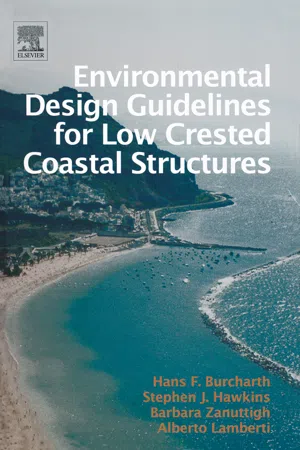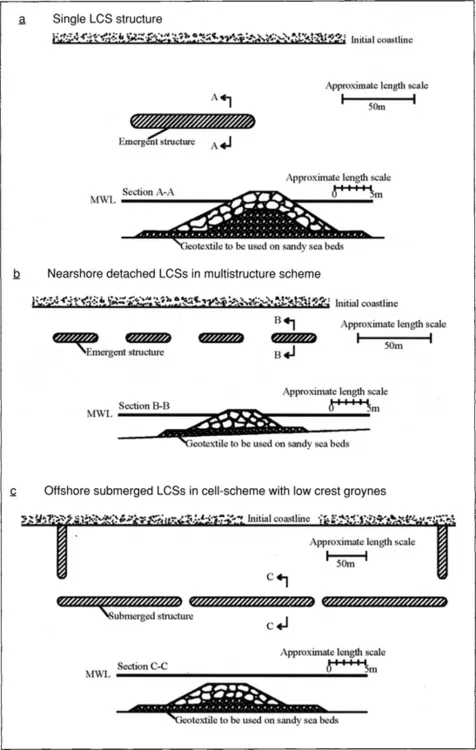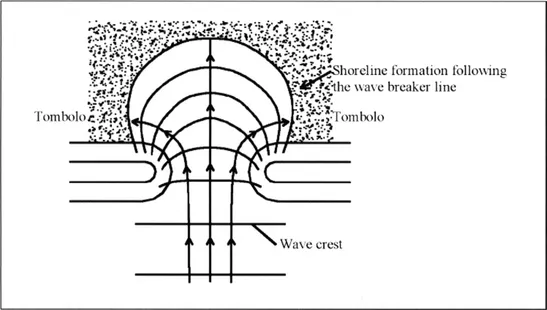![]()
Part I
Guidelines
![]()
CHAPTER 1
Definition of LCSs covered by the guidelines
(Burcharth, AAU)
The guidelines cover shore-parallel low crested and submerged structures such as regularly overtopped emergent and submerged detached breakwaters. Whilst LCSs share engineering and ecological features with artificial reefs, these are considered as a separate issue as they are very wide crested, deeply submerged and deployed mainly to enhance fisheries.
The structures reduce the amount of wave energy reaching the shore behind them and as a consequence also influence sediment transport and impose shoreline changes.
LCSs can be constructed as a single structure (Figure 1.1a) or in series (Figure 1.1b). A single structure is used to protect a localized area, whereas a multiple segmented system is designed to protect an extended length of shoreline.
Figure 1.1 Examples of layouts and cross sections of LCSs.
Submerged breakwaters might be constructed as long continuous structures in which case gaps might not be strictly necessary for water exchange. In schemes with emergent breakwaters or slightly submerged structures such gaps might be provided anyway to allow passage of boats. Figure 1.1c shows an example of a scheme consisting of long submerged breakwaters with small gaps between them. Also shown are some submerged terminal groynes forming a cell configuration often used to retain artificial sand fills.
Single structures as shown in Figure 1.1a are usually built in water depths of more than 3-4 metres with the objective of reducing or stopping coastal erosion at a single location and at the same time creating a sheltered area for swimming or mooring of boats. Detached breakwaters in multi-structure schemes are often constructed in very shallow water of few metres water depth close to the shoreline with the single objective of protecting a beach against erosion and flooding of low-lying areas. If built at some distance from the shoreline the objective would most often be a combination of beach protection and creation of a suitable area for recreational usage.
The structures are most commonly constructed of stone material (cf. the cross sections in Figure 1.1). Concrete blocks are used for the armour layers if suitable rock material of sufficient size is not readily available.
Revetments or seawalls are often constructed along the coast as part of LCS-schemes in order to strengthen very exposed coastlines.
![]()
CHAPTER 2
Function of LCSs
2.1. LCSs INTERACTION WITH WAVES, CURRENTS AND SEDIMENT TRANSPORT
(Burcharth, AAU)
When used for beach stabilization the function of LCSs is to reduce wave energy in their lee and thereby reducing the sediment carrying capacity of the waves to the shoreward. They can be designed to reduce or prevent the erosion of an existing beach or a beach fill, or to encourage natural sediment accumulation to form a new beach.
The structures reduce the incoming wave energy across the structure by triggering wave breaking at and on the structure, by partially reflecting the waves and by dissipation related to the wave induced porous flow in the structure. This is illustrated for an emergent structure in Figure 2.1.
Figure 2.1 Illustration of the sheltering effect of an emergent LCS by reduction in shorewards transmitted wave energy by wave breaking, wave reflection and porous flow.
Wave breaking accounts for the largest part of the energy reduction, reflection for the second largest part and porous flow for the smallest part. Wave energy is also transmitted horizontally by diffraction and refraction around the heads of the structure into the lee zone as illustrated for an emergent structure in Figure 2.2.
Figure 2.2 Illustration of spreading of wave energy by diffraction and refraction in gap between emergent structures.
In the case of shorter emergent structures with only limited overtopping the horizontal wave transmission will dominate. The lower the crest level the more dominant will become the wave disturbance caused by overtopping waves. For long submerged structures the wave disturbance is caused almost completely by wave transmission over the crest.
Depending on the sheltering effect of LCSs, more or less littoral material is deposited and retained in the sheltered area behind the structures. If moderately sheltered the sediment will typically appear as a bulge in the beach planform termed as a salient. If more protected, the resulting shoreline extends out to the structure thus forming a so-called tombolo (cf. Figure 2.3).
Figure 2.3 Illustration of tombolo and salient.
The actual morphodynamic changes are to a large extent also determined by currents; not only the tide and storm surge generated currents on the coastal stretch, but indeed by the currents generated locally at and around the structures by wave-structure interaction. Waves passing over a LCS result in a net transport of water across the structure inducing a higher mean water level in the lee of the structure. This creates a seaward net transport of water through the porous structure, but more importantly also horizontal currents and vortices in the lee zone due to head gradients towards the ends of the structures.
The patterns of the currents are different in case of emergent and submerged structures, see Figure 2.4 and 2.5.
Figure 2.4 Illustration of wave induced currents behind emerged structures without wave transmission across the structures.
Figure 2.5 Illustration of wave induced currents in case of submerged structures with wave transmission across the crests. Note the very strong outgoing rip-currents in the gaps.
The net transport of water into the lee zone causes a water level rise and is balanced mainly by outgoing currents at the heads of the structures. In case of multi-structure schemes these currents will be manifested as concentrated and eroding rip currents in the gaps between the structures (cf. Figure 2.5).
Like other hard structures, LCSs have some drawbacks. Salients or tombolos can interfere with longshore currents and sediment transport and create almost always downdrift erosion on coastlines with one dominating sediment transport direction along the coast (see Figure 2.6). Tombolos have in this respect a stronger negative effect than salients. Moreover, emergent LCSs forming schemes with rather closed cells might result in stagnant water of poor quality. Also the visual impact of emergent structures can be negative at locations of high scenic value.
Figure 2.6 Illustration of downdrift erosion and updrift accretion caused by formation of tombolos and salients shoreward of detached breakwaters.
These factors have resulted in a move towards design of structures with a very low crest or fully submerged.
At a given location and water depth the lower structures are cheaper in material but are less effective in attenuating wave energy than surface-piercing structures. Thus the optimum design will be a balance between these aspects.
Predictions of the actual morphological changes imposed by LCSs, local as well as more distant, are difficult due to the complicated interaction between waves, water levels, currents and sediment transport. These factors change considerably in most places not only over the year but also from year to year. Stable long-term-average beach profiles will not be reached on eroding coasts unless beach nourishment is provided or sufficient natural supply from remote sources is not interrupted.
2.2. ENVIRONMENTAL CONSIDERATIONS AND CONSEQUENCES
(Moschella, MBA; Abbiati, FF; Aberg, UGOT; Airoldi, Bacchiocchi, Bertasi, Bulleri, Ceccherelli, FF; Cedhagen, BIAU; Colangelo, FF; De Vries WL-DH; Dinesen; BIAU; Gacia, CSIC; Granhag, UGOT; Jonsson, UGOT; Macpherson, Martin, Satta, CSIC; Sundelöf, UGOT; Thompson & Hawkins, MBA)
Coastlines are highly dynamic systems subject to geo-morphological processes such as erosion, sediment transport and vertical land movement. These natural processes lead to continuous changes in the coastline that can be affected by human activities.
LCSs, as many man-made constructions in the sea, will have consequences for the natural environment and coastal landscape. These consequences occur at local scale, but may also scale up to the whole coastline. Effects may be site specific, reflecting the complexity, uncertainty and variability of natural systems. Therefore knowledge of environmental context...







